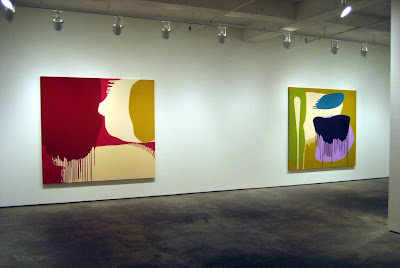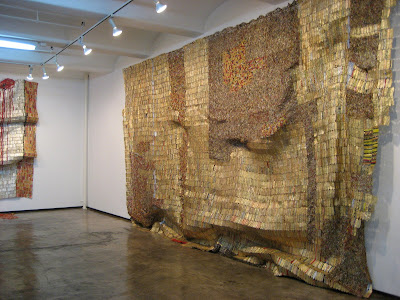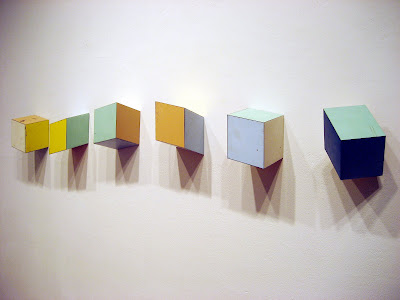
2.24.2008
The Women's Room

2.17.2008
Paintings and Process--Thirty Years Apart

Larry Poons at Jacobson Howard: Festinniog, 1975, acrylic on canvas, 78 x 69.5 inches
If you read this blog regularly, you know that while geometry is a recurring theme, I'm just as interested in material and process. It is those two latter issues we'll consider in this post via a couple of New York shows--one still up, the other now closed--both with references to nature.
Larry Poons at Jacobson Howard Gallery through March 1
"Throw, Pour, Drip, Spill and Splash" offers a fine selection of Poons’s paintings from the Seventies and Eighties. True to the title of the show, these are paintings at their most process intensive. Layers of paint in frozen rivulets and and richly encrusted surfaces still resonate with the energy of their making, an effect heightened by their large size in relation to the two small rooms of the Upper East Side gallery in which they’re shown.
There was nothing in the gallery information that made reference to landscape, yet the paintings themselves recall all manner of nature and of the payssage: mossy earth, flowered fields, waterfalls. Perhaps I'm reading them too literally, but I see what I see. lllglg

Tantrum 2, 1979, acrylic on canvas, 65 x 165 inches
Detail below
Carolanna Parlato at Elizabeth Harris Gallery, through Feb. 2
Downtown, in "Nature Games," a show that closed on February 2, Carolanna Parlato showed work in the same vein. While her m.o. would seem to cover the same territory as Poons, her process is much more controlled; the enamel-like paint flowed and dripped but only, it seems, until she said, "Stop." The paintings are worked in saturated, uninflected colors, yet the topographical quality of the pentimenti and the substantiveness of the drips show you just how much dimension "flat" can have. (Both painters work in acrylic, by the way.)
Parlato makes a direct reference to landscape in her statement, but I see her elements more as land mass. It's the process here that engages me, and the pleasure of materiality that is just under--and essential to--that glossy surface.

Below: The Kiss, 2007, acrylic on canvas, 72 x 80 inches; image from the gallery website



2.14.2008
El Anatsui at Jack Shainman

Fading Scroll, 2007, aluminum and copper wire, 88 x 472 inches
I have given up trying to cover gallery shows while they’re still up. That’s the job of a paid journalist. My reportage is typically presented after the fact, and until my twin clones are perfected, that’s probably the way it will remain.
So here we are at the Jack Shainman Gallery on 20th Street at the end of January. The show is El Anatsui’s "Zebra Crossing." God, I love this work: large, fluid expanses that hang slightly away from the wall, occasionally bulging or sagging as they yield their great weight to gravity.
Detail below
Zebra Crossing III, 2007, aluminum and copper wire, 61 x 107 inches
Detail below

The work embodies some lovely dualities. There’s an underlying geometry to the structure. Strips of metal—the aluminum wrapping from the neck of liquor bottles—are pierced and held together with twisted wire, row-on-row, but the overall effect is one of fluidity and organic growth. The patterns are textile-like in their structure, like Ghanian kente cloth, but sculptural in their presence. The work is made of junk, but the light shimmers sublimely across the surface. And of course there’s the metaphor of transcendence. It took the labels from a damn lot of devil water to make this celestially beautiful work.

Area B, 2007, aluminum and copper wire, 155 x 236 inches
You can call this work sculpture, tapestry or painting, and any description would be correct.
El Anatsui is a professor of sculpture at the University of Nigeria, so perhaps sculpture is the word he would use. But the relative flatness of the surface suggests painting. Think, for instance, of the gilding and drape of Klimt. And the structure does suggest tapestry. Are you familiar with the work of Colombian-born artist Olga de Amaral, whose large scale tapestries are painted and gilded? See both below.

.
.
,
.
Above, Klimt: Portrait of Adele Bloch-Bauer I, 1907, oil on canvas with gold and silver gilding, now at the Neue Gallery, New York City; The Kiss
Below: Olga de Amaral, Cesta Lunar, fiber, gold leaf, acrylic

More El Anatsui: Takari in Black, 2007, aluminum and copper wire, 60 x 76 inches. This one is my favorite. I particularly like the coolness of the silvery hue, and the organic geometry of the composition.
Detail below

In case you’re interested, the prices ranged from $250,000 for the smaller works, such as the one above, to $500,000 for the big one that opened the post And every single one on the gallery list had a red dot. A sante!
2.09.2008
On the Geometric Trail: Part Five
On the Geometric Trail, in Chelsea
On the Geometric Trail, Part Two: SoHo
On the Geometric Trail, Part Three: Isensee

Don Voisine: Poised, 2007, oil on wood, 20 x 20 inches
Valerie McKenzie always puts on a good show. This group exhibition brings together gallery and invited artists to examine the multiplicity of sources and expressions of geometric art. Artists in the show are Chris Gallagher, whose gently curving stripes suggest the celestial, like rings around Saturn; Kim MacConnell, with saturated abstractions reminiscent of Matisse and Picasso; and Shari Mendelson, whose chandelier-like sculptures play with light and shadow. You can see their work on the gallery website.
Here I'm homing in on the three whose geometry resonated most strongly for me: Don Voisine, whose work opens this post; Jennifer Riley, whose paintings have been turning up everywhere lately (including at McKenzie Fine Art's booth at Art Miami and OH&T's booth at Aqua Wynwood); and Ann Pibal, whose small-scale paintings are surprisingly poetic for their stark linearity.
Jennifer Riley: This installation shot looks into the office from the gallery. Foreground, Remedy for Blunt Footing, 2007, oil on canvas, 54 x 40 inches; office: Into the Maelstrom, 2007, oil on canvas, 44 x 60 inches
Riley's work suggests landscapes and topographies--mountains, rolling hills--but in a geometric style that references computerized maps. The deep space offered to the viewer is all the more compelling for the flatness of the surface. The push/pull of these elements, with the addition of gorgeous color, makes the work irresistible.
Don Voisine's geometry is much more austere: reductive and smack up against the picture plane. But up close his austerity is softened by surprisingly gentle surfaces--one soft, velvety black; another not quite shiny but not quite matte; yet another with the light shimmer of unexpected brushstrokes. Indeed, the picture plane opens more deeply than a first look would suggest. You need to spend time with this work. I'd call it "tender constructivism."
Don Voisine: Above, an installation in the office looking into the gallery at the painting shown below. Below, Delayed Green, 2007, oil on wood, 32 x 63 inches


Ann Pibal: Above, TRPSH, 2007, acrylic on aluminum, 12 3/4 x 18 1/2 inches; below, B-Line (v.2), 2007, acrylic on aluminum, 13 x 19 1/4 inches

Pibal's paintings, unique in their small scale and lovely color, nevertheless allow me to make some visual connections within geometric abstraction: to Miriam Schapiro's famous Ox painting, currently part of the "Wack" show (opening February 17 at PS 1) to Frank Stella's early geometries, and to Warren Isensee's Body and Soul, which I posted recently. You'd think there's only so much you can do with the same shapes and angles, but the connections, the variations, the subtleties, all filtered through the eye and hand of the artist, are endlessly new. Pibal's work reminds me of all that.
2.08.2008
The Geometry of Finance

A fellow named George has a money blog called Future Modern Finance. I found it because he posts on Ed Winkleman's blog, and Ed attracts a variety of interesting people with blogs, and opinions, that encompass not only art but politics and finance--you know, the other things that go on while we're in our studios.
This chart represent some of the splendid visuals I found at George's blog. I realize there's a financial narrative here (this one is a week of trading on Sotheby's stock), but I am just digging the beauty of the geometry.
2.06.2008
On the Geometric Trail: Part Four
Sol LeWitt: Wall Drawing #604A-Cubic Rectangle with Color Ink Washes Superimposed, 1989
This work was the centerpiece of "Deconstructed Geometry," which ran officially until January 17 but was still up when I stopped in at the end of the month.
Ted Larsen: Chicklets, 2007, 6 x 6 x 6 inches
This solo show is at OK Harris through February 9th
OK, so I'm stating the obvious, but here's what I love about this pairing of Sol LeWitt and Ted Larsen: big versus little, flat versus dimensional, concept versus object, saturated versus pale, light versus shadow, uptown versus downtown. These kinds of connections sometimes occur as I'm viewing work, other times as I'm viewing the images after the fact. In this instance, geometry was the thread connecting a number of shows I've seen and posted about this winter, but it was not until I sat down to edit these particular images did this pairing fall into place. I'd call it the conceptual version of the kids' toy that requires you to fit a shaped block into the correspondingly shaped hole--even though none of the shapes is quite exactly the same.
2.02.2008
On the Geometric Trail: Part Three
On the Geometric Trail, Part Two: SoHo
We’re back on the Geometric Trail. (Previous posts can be linked, above.) This time we’re visiting Danese Gallery, where Warren Isensee has a show up until the 9th of this month.

On the far wall, Body and Soul, 2007, oil on canvas, 78 x 120 inches. Foreshortened at left, Bipolar Express. We'll swing around to a full view of that painting.
I’m not sure there’s a more perfect space for this work than Danese's skylighted aerie. The high ceilings and broad loft expanse create a welcoming environment for paintings that resonate so visually they seem to radiate off the walls and into the the room.
Isensee employs rectilinear shapes that he limns and relimns to create forms within forms. There’s both a textile sensibility (like a Navajo chief blanket) and an architectural structure to the work (columned temples, perhaps) that come together to create intimacy and grandeur at the same time. They’d be hallucinogenic except that the palette is grounded in saturated earthen hues—like Fiestaware without the kitsch. On second thought, forget trippy. Those celadons and ochres, sienas and corals are rubbing up against one another to the point of retinal orgasm. Ahem, chromatic fervor.
.
Let's continue our spin around the large main gallery:
 Body and Soul, again, leading to . . .
Body and Soul, again, leading to . . .

Scenic Overlook in the foreground with New Construction, 2007 oil on canvas, 60 x 60 inches, on the far wall. Just to the right of New Construction is . . .
. . . a wall of framed colored pencil drawings. They're startling, because the are the line-by-line, color-by-color starting point for many of these big paintings. You can see the drawings for Body and Soul and New Construction second and third from left
This is not the best picture of a very fine painting (you can see the color much better on the gallery website), but I wanted to take you back to the starting point of our tour, where this painting was shown in greatly foreshortened perspective. It's Bipolar Express, 2007, oil on canvas, 48 x 72 inches
Part of the visual excitement of Isensee's painting comes as much from the quality of the line as from the juxtaposition of the colors. It looks as if he paints the stripes with a flat brush, sans tape, so the ever-so-slight line variations within each stripe combine to generate many more visual watts than hue or color placement alone could do.
Next time: Ted Larsen's small dimensional geometries at OK Harris in SoHo, and Sol Lewitt's wall drawing uptown at Vivian Horan Fine Art; then back to Chelsea for "Geometric Abstraction," a group show at McKenzie Fine Art.























